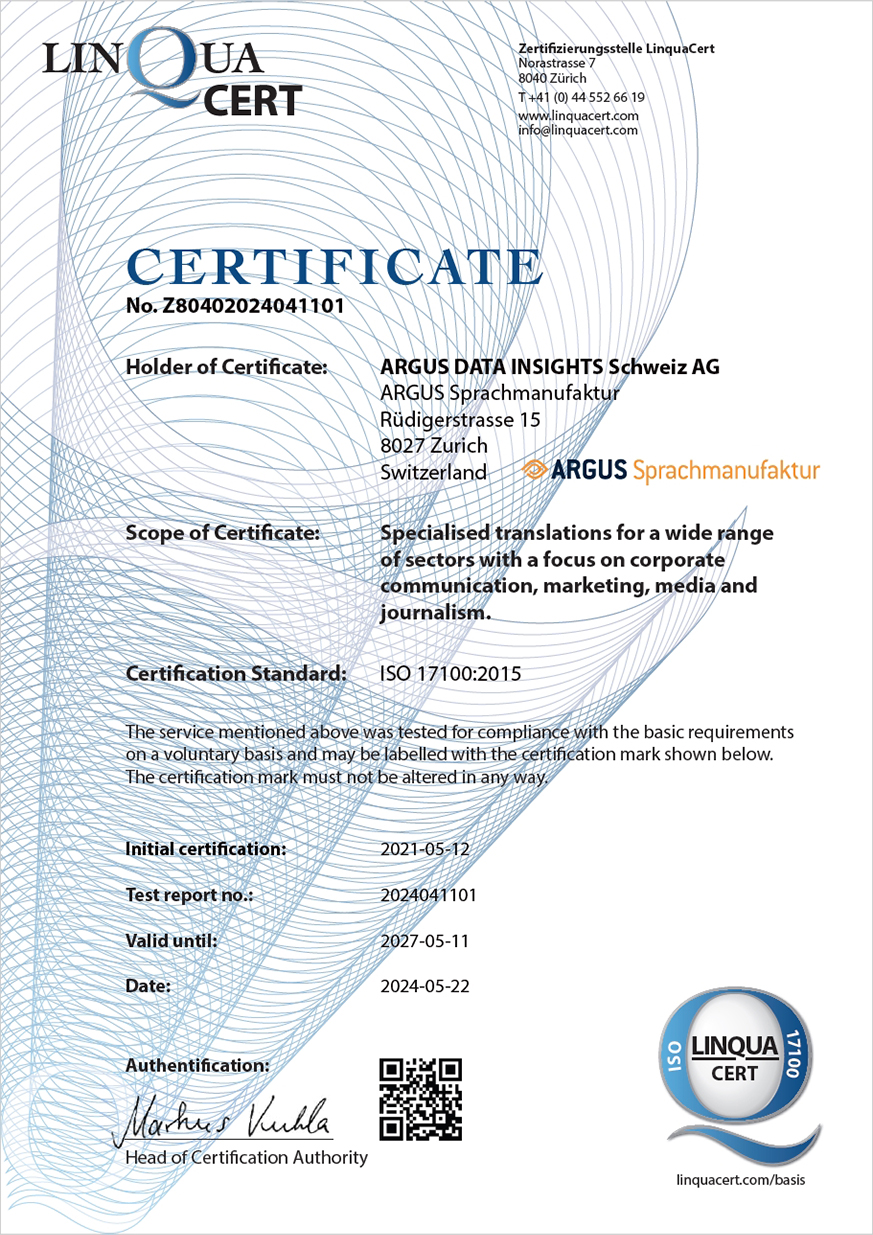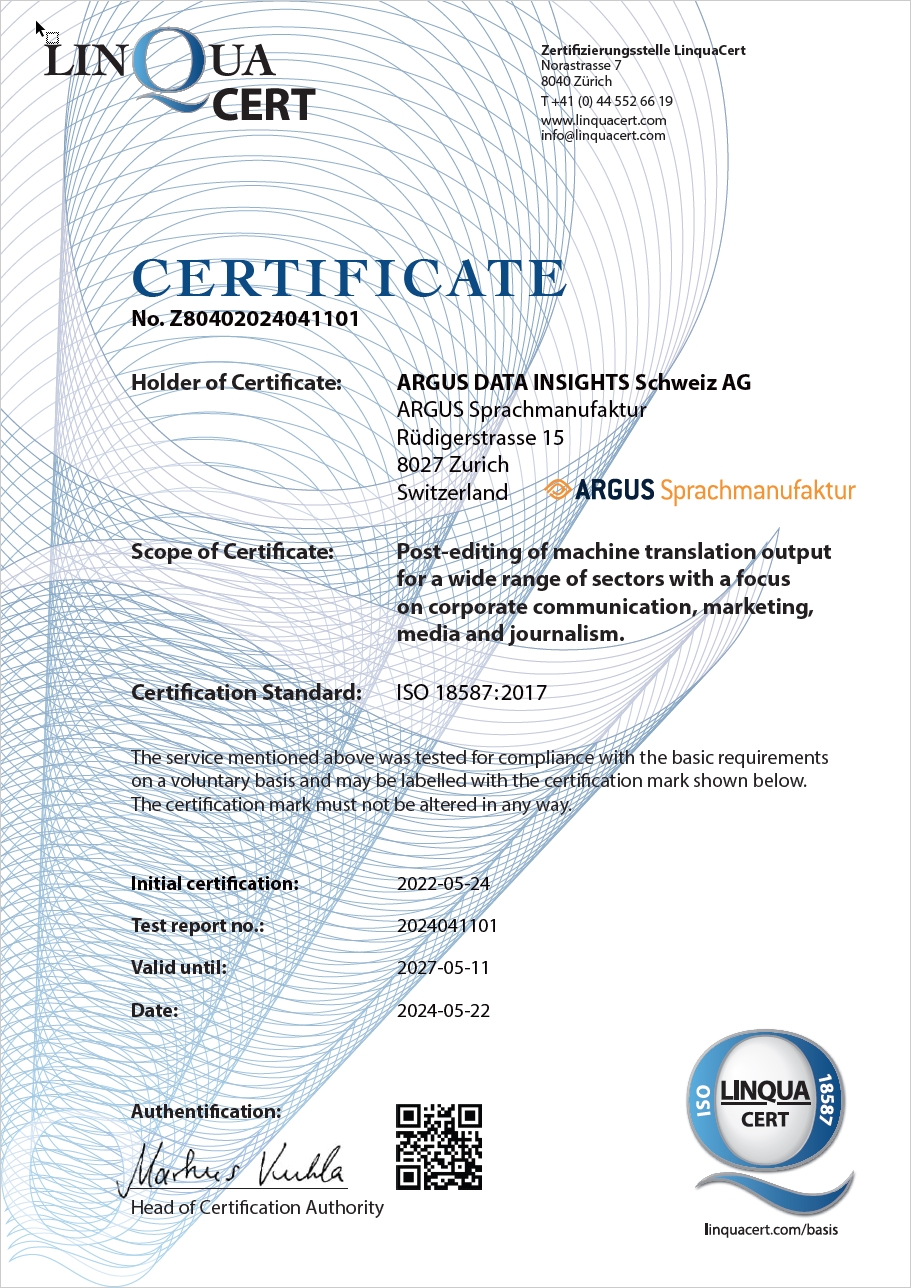Certifications
Quality guaranteed:
it's official!
What does being certified to ISO 17100 standard mean?
DIN EN ISO 17100:2015 is the internationally applicable quality standard for translation service providers. It sets out the requirements for all aspects of the translation process that directly affect the quality of translations, and provides a uniform definition for the key terms relating to translation management. It includes the following:
Handling of core procedures
The first core procedure is project preparation, including cost estimates, feasibility studies, clarification of technical aspects, gathering of project-specific information, and various administrative activities. A single project manager at ARGUS Sprachmanufaktur oversees the project from A to Z. You can find out more about what other activities come under their remit in the blog post 'Was macht eigentlich ein Projektmanager*in bei einem Sprachdienstleister' (What does a language services project manager actually do? – post available in German only).
Then there is the production process, including the four-eyes principle: every translation is revised by a second qualified translator. The revisor compares the content in the target language to the content in the source language with regard to the text's intended purpose, and corrects any errors or other issues.
Project follow-up is also extremely important under ISO 17100. There has to be a procedure for client feedback. The Plunet client portal allows you to leave feedback on your projects at any time. Complaints can also be lodged, and appropriate measures put in place. In addition, the feedback is always forwarded to the translators involved and stored in our translation memory for future translations.
The translation workflow
Project preparation --> Production process --> Project follow-up
Request processing
- Translation
- Project completion
- Quote/confirmation
- Revision
- Project feedback
- Project-specific information
- Verification and approval
- Complaints
Resources' qualifications and skills:
ISO 17100 defines the minimum requirements for the qualifications of resources (translators, revisors, project managers, etc. ) and for making sure resources' skills are regularly reviewed and kept up to date in their profiles. We have always worked exclusively with qualified translators who have experience in the relevant subject areas and language regions.
Technical and technological resources:
Service providers must have the required infrastructure and the necessary tools. In terms of translation technology, we use the CAT (computer-aided translation) tool SDL Trados Studio and the GroupShare Server, where we store what are known as translation memories and termbases. We use the translation management tool Plunet to manage our projects even more efficiently, simply and securely. We are, of course, still remaining true to our slogan 'We use as much technology as necessary and as much brainpower as possible', but there are certain tools that we need.
Project-specific information is also important and must be made available to all resources involved. We have now optimised this process further by sending translators specific work instructions as per ISO 171000 with each purchase order, and making all information relating to the project directly accessible when they are working on the relevant files.
Security of information and secure data storage are also key elements of the ISO standard, and something that we have now documented in detail. We also require all translators to sign a confidentiality agreement, and all texts and information are treated strictly confidentially.
What does being certified to ISO 18587 standard mean?
DIN EN ISO 18587:2017 is an international quality standard for post-editing machine translations. It sets standards for post-editing, increases the efficiency of machine translation processes and lays down requirements for the qualifications and skills post-editors should possess.
Definition of post-editing
The use of machine translation is rapidly gaining pace, as is the quality of machine translations. Pre-translating a text using a machine can be a good solution for certain translation projects, especially if these have a very quick turnaround time and/or there are budgetary restrictions to be considered. However, machine translations are still not able to compete with human translations as far as quality is concerned and are therefore not well suited for texts that are going to be published. The text produced must therefore be checked and corrected using post-editing. That's where we come in!
There are two types of post-editing: light and full post-editing. ISO 18587 mainly deals with full post-editing. With full post-editing, a machine pre-translation is checked for accuracy and clarity, its readability is improved and mistakes are corrected.
The benefits of professional post-editing
We use DeepL Pro to create the machine pre-translation in our CAT tool, SDL Trados Studio. This ensures data security. We also integrate our client-specific translation memory and terminology database into the machine pre-translation process. This helps to ensure consistency with your previous translations and to improve the output quality. All of our freelancers possess the qualifications and skills necessary to provide professional post-editing as stipulated in the ISO 18587 and ISO 17100 standards.
The core phases of a post-editing project
The post-editing of computer-generated translations involves three core phases:
- Project preparation
- Production process
- Project follow-up
During the project preparation phase, the project manager checks whether machine translation would be suitable for the source text. After all, the efficiency of post-editing depends on the language pair, subject matter and style of the content.
The production process consists of producing a machine translation using DeepL Pro, which the post-editor then compares to the source text and revises it accordingly. Throughout the production process, the focus remains on what the end goal of the project is as well as on the requirements in place for both the post-editing work and the post-editors.
The project follow-up phase involves collecting feedback from the post-editors about the quality of the machine translation and checking the final product before delivering it to the client.
Still have questions?
Our team would be happy to answer them!


